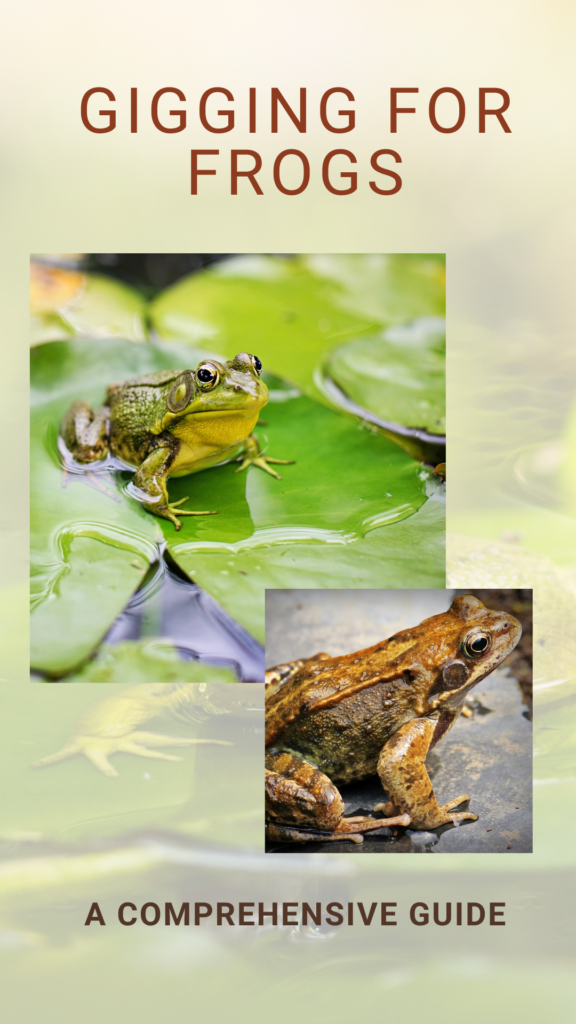Gigging for frogs is a popular pastime for many people, especially in rural areas. It involves using a gig, a long pole with a sharp prong at the end, to catch frogs at night. While some people do it for sport or food, others do it to help control the frog population in their area.

Understanding frog gigging is important before attempting to go out and catch frogs. It is essential to know the laws and regulations in your area, as well as the different types of frogs that are safe to catch and eat. Additionally, it is important to have the right equipment and safety gear before heading out into the field.
Key Takeaways
- Before attempting to go frog gigging, it is important to understand the laws and regulations in your area, as well as the different types of frogs that are safe to catch and eat.
- Proper preparation, including having the right equipment and safety gear, is essential for a successful and safe frog gigging experience.
- Those who participate in frog gigging can help control the frog population in their area, while also enjoying the sport and obtaining food.
Understanding Frog Gigging
Frog gigging is a popular pastime that involves hunting frogs at night using a gig, a long pole with a multi-pronged spear at the end. In this section, we will discuss the history and tradition of frog gigging, the regulations and laws governing this activity, and ethical considerations that must be taken into account.
History and Tradition
Frog gigging has been around for centuries, and it is deeply rooted in the traditions of many cultures. Native Americans used to hunt frogs for their meat, and the French have been known to enjoy frog legs as a delicacy for centuries. In the United States, frog gigging is most popular in the southern states, where bullfrogs are abundant.
Regulations and Laws
Before going frog gigging, it is important to check the regulations and laws in your area. Most states have specific rules regarding the hunting of frogs, including limits on the number of frogs that can be taken, the season during which they can be hunted, and the methods that can be used. Violating these regulations can result in fines or even criminal charges.
Preparation for Frog Gigging
Frog gigging is a popular outdoor activity that requires some preparation to ensure a successful and safe experience. In this section, we will discuss the essential gear and equipment, choosing the right location, and safety precautions to take before heading out.
Essential Gear and Equipment
To start, we need to have the right gear and equipment. The following is a list of essential gear that we need to have before heading out:
- Gigging equipment: A gig is a multi-pronged spear used to catch frogs. Make sure to have a good-quality gig that is sturdy and sharp.
- Headlamp or flashlight: Frog gigging is usually done at night, so we need a reliable source of light to see and aim accurately.
- Appropriate clothing: Wear clothing that is comfortable, lightweight, and suitable for the weather conditions. It is also essential to wear clothing that is dark or camouflaged to avoid spooking the frogs.
- Waterproof boots: Since we will be wading through water, we need to wear waterproof boots that provide good traction and support.
- Bucket or cooler: We need a container to store the frogs we catch.
Choosing the Right Location
The next step is to choose the right location. We can find frogs in various bodies of water, including ponds, lakes, rivers, and swamps. It is essential to scout the area during the daytime to familiarize ourselves with the terrain and identify potential hazards.
Also, we need to research and obtain permission to access private property. We should avoid public areas that are off-limits or have restrictions on frog gigging.
Safety Precautions
Frog gigging can be a dangerous activity if we do not take the necessary safety precautions. Here are some safety tips to keep in mind:
- Always wear a life jacket when wading through deep water.
- Use a gig with a safety tip to prevent accidentally stabbing yourself or others.
- Avoid areas with strong currents, deep holes, or underwater obstructions.
- Watch out for snakes, alligators, and other wildlife that may pose a threat.
- Never consume frogs that have not been properly cleaned and cooked.
In conclusion, preparation is key to a successful and safe frog gigging experience. By having the right gear and equipment, choosing the right location, and taking the necessary safety precautions, we can enjoy this exciting outdoor activity while minimizing the risks.
Frog Gigging Techniques
When it comes to frog gigging, there are several techniques that can help ensure a successful catch. Here are some tips and tricks to help you identify target species, stalk and spot frogs, and effectively use your gig.
Identifying Target Species
Before you head out for a night of frog gigging, it's important to know the species you're targeting. In North America, the most common species are bullfrogs, green frogs, and leopard frogs. The American bullfrog is the largest and most sought-after species, but it's important to check local regulations before gigging any frogs.
To identify a frog species, look for distinguishing features such as the size and shape of the eyes, coloration, and patterns on the skin. The American bullfrog has large, prominent eyes and a greenish-brown coloration, while green frogs have a bright green coloration and leopard frogs have distinctive spots on their skin.
Stalking and Spotting Frogs
Once you've identified your target species, the next step is to stalk and spot them. Frogs are most active at night, so it's important to bring a good flashlight and move quietly to avoid scaring them off.
Look for frogs near the edges of ponds, streams, and other bodies of water. They often hide in vegetation or under rocks and logs. When you spot a frog, move slowly and quietly toward it, keeping your flashlight pointed away from its eyes to avoid startling it.
Effective Use of Gig
When it comes to using your gig, there are a few key techniques to keep in mind. First, make sure your gig is sharp and in good condition. A dull gig can make it difficult to penetrate the frog's skin and secure your catch.
When you're ready to gig a frog, hold your gig pole firmly with both hands and aim for the center of the frog's body. The tines of the gig should be facing forward, and you should aim to strike the frog with a quick, forceful motion.
Once you've successfully gigged a frog, use your gig pole to lift it out of the water and onto the bank. Be careful not to damage the frog's skin or internal organs, as this can affect the quality of the meat.
These frog gigging tips can help you become a more successful and responsible frog hunter. Remember to always follow local regulations and practice good conservation practices to ensure the sustainability of frog populations for future generations.
Post-Gigging Processes
After a successful gigging session, it's important to handle and process the catch properly to ensure its quality and safety. In this section, we will cover the two main post-gigging processes: Handling and Storage, and Cleaning and Cooking.
Handling and Storage
Once the frogs are caught, it's important to handle them with care to prevent any damage to the meat. We recommend using a cooler to store the frogs immediately after catching them. Make sure to keep the cooler in a cool and dry place to prevent spoilage.
It's important to note that frogs should be processed as soon as possible after catching them to ensure their freshness. If you're unable to process them right away, you can store them in the cooler with ice to keep them fresh for up to 24 hours.
Cleaning and Cooking
Cleaning and cooking frogs can be a bit tricky, but with the right techniques, it can be a delicious and rewarding experience. Before cleaning the frogs, make sure to rinse them thoroughly with cold water to remove any dirt or debris.
To clean the frogs, start by removing the legs. Cut through the skin around the base of the legs and pull them away from the body. Once the legs are removed, you can clean the body cavity by removing the organs and rinsing the inside with cold water.
There are many ways to cook frog legs, but one of the most popular methods is to fry them. To fry frog legs, season them with salt and pepper, and then coat them in a mixture of flour and cornmeal. Heat up some oil in a pan and fry the legs until they're golden brown and crispy.
Overall, handling and processing frogs after gigging is a simple process that requires some care and attention. By following these tips, you can ensure that your catch is fresh, tasty, and safe to eat.
Conservation and Sustainability
As advocates for the protection of wild amphibians, we take conservation and sustainability seriously. We understand the importance of protecting these species and ensuring their survival for future generations.
In many areas, amphibians are protected species, and it is important to follow local laws and regulations to ensure their safety. We always check with the state wildlife department to see if any permits are required before conducting any gigging activities.
When gigging for frogs, we make sure to only take what we need and to avoid harming any other wildlife in the area. We understand that amphibians play a crucial role in the ecosystem, and we strive to maintain a healthy balance.
We also prioritize sustainability by only gigging during certain times of the year, when the populations are at their highest and the impact on the environment is minimized. We avoid areas where amphibians are known to be in decline and focus on areas where populations are thriving.
Overall, we believe that gigging for frogs can be done responsibly and sustainably, while still allowing us to enjoy this unique outdoor activity. By following local laws and regulations, respecting protected species, and prioritizing conservation and sustainability, we can ensure that future generations will be able to enjoy the thrill of gigging for frogs.
Frequently Asked Questions
What equipment is essential for frog gigging?
To successfully gig for frogs, you will need a few essential pieces of equipment. A gigging pole, which is a long pole with a sharp, multi-pronged spear at the end, is the primary tool used to catch frogs. Additionally, a good pair of waders (we love Orvis' Clearwater Waders!) or waterproof boots is necessary to navigate through the water and mud. A headlamp or handheld flashlight is also important for visibility in the dark.
What is the most effective light to use while frog gigging?
The most effective light for frog gigging is a high-powered LED headlamp with a green or white light. These lights are bright enough to illuminate the water and surrounding areas, but they won't scare off the frogs like a bright white light can.
During which months is frog gigging typically most successful?
Frog gigging is typically most successful during the warmer months of the year, from late spring to early fall. This is when the frogs are most active and plentiful.
What are the legal considerations when gigging for frogs?
It is important to check with your local wildlife agency to ensure that frog gigging is legal in your area and to obtain any necessary permits. In some areas, there may be restrictions on the number of frogs that can be caught or the size of the frogs that can be harvested.
How is a frog gig constructed?
A frog gig is typically constructed with a long wooden or metal pole and a multi-pronged spear at the end. The spear can be made from metal or wood, and the prongs should be sharp enough to penetrate the frog's skin.
What are the ethical implications of frog gigging?
Frog gigging can be a controversial activity, and it is important to consider the ethical implications before participating. Some people believe that frog gigging is cruel and unnecessary, while others see it as a traditional and sustainable way to harvest food. It is important to practice responsible frog gigging and to only take what you need.

